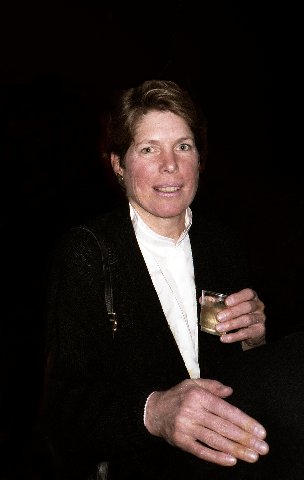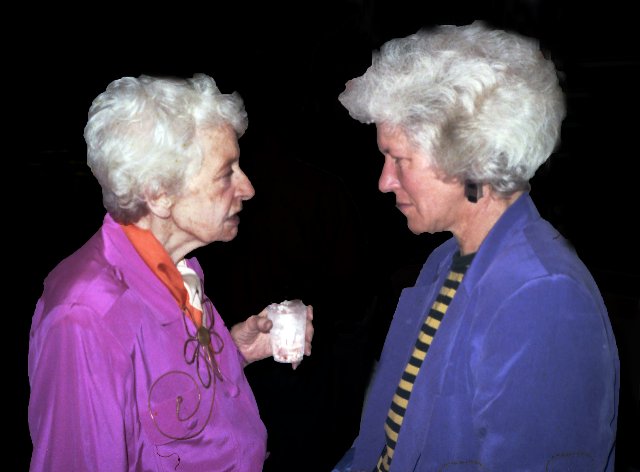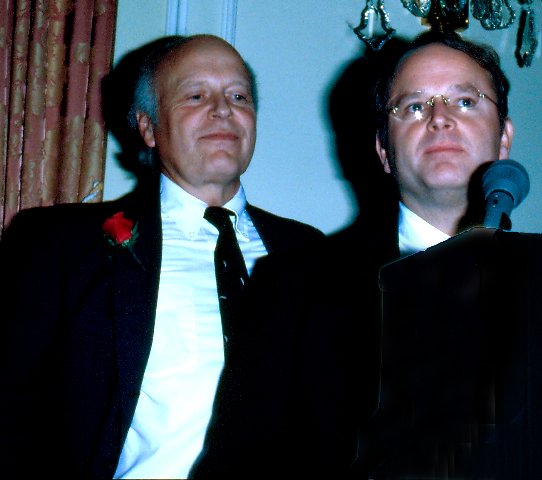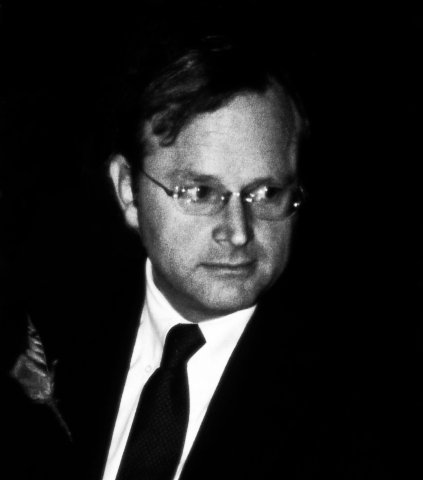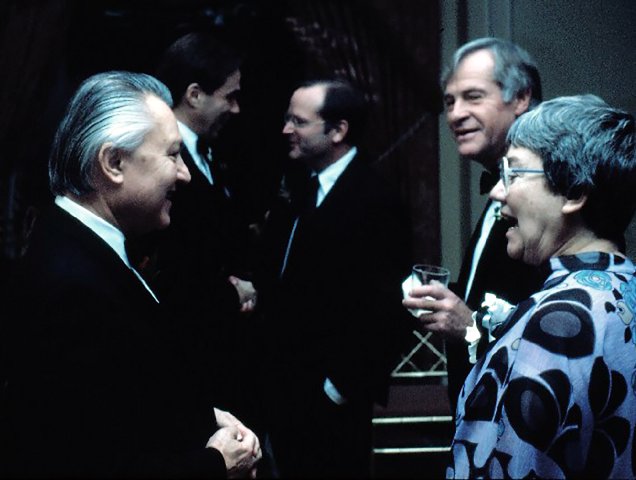Former ICA Director Sydney Roberts Rockefeller
Recalling Events 1973-1974
By: Charles Giuliano - Apr 15, 2020
The ICA was dead in the water when it was evicted from 100 Newbury Street in 1968. Lock, stock and barrel it was mothballed in its former failed venue at an inaccessible location on Soldier’s Field Road in Brighton.
With a wish and a prayer, on a long shot, the keys were turned over to Andrew C. Hyde. He had worked for Boston's Summerthing and was connected to the new Mayor Kevin White through Deputy Mayor Katherine Kane. She and her husband Louis were ICA patrons.
Hyde got the ICA up and running through a series of city connected venues. Five years later he was burned out. As a work of conceptual art Chris Cook, on leave from the Addison Gallery, signed on for a one-year term.
When Cook’s term ended in September, 1973 the charismatic but flaky Hyde was invited back. That relaunch sputtered and soon the ICA was left in the lurch. The board prevailed on one of their own to leap into the breach.
Sydney Roberts Rockefeller, a sculptor, had joined the board when she was twenty-seven. The ball landed in her lap during a time of transition when the ICA was renovating a new home at 955 Boylston Street. She was offered an annual salary of $5,000 a fraction of what was paid to Hyde.
There were immediate problems to solve. After a year she was pushed out by the ambitious Gabrielle Jeppson who had the support of the architect Graham Gund. Then a board member, he was the designer and primary funder of the new ICA.
Researching my history of the ICA Sydney was able to fill in gaps regarding the transition from Hyde to Jeppson. After the ICA she had a long association as chairperson of the board of the Brockton Art Museum. She has continued making and exhibiting art. Today she pursues a range of projects and philanthropies. When we connected, she was helping to install an exhibition of costumes to which she contributed.
Charles Giuliano Let’s look at events in 1973-1974 when you were director of the ICA.
Sydney Roberts Rockefeller I became ever less involved which is something I want to talk with you about. Isabelle Storey helped me a lot but things were getting complicated.
(Isabelle Storey was an ICA curator at the time. In 2007 she published “Walker's Way: My Years with Walker Evans.” It is unclear when or why Storey left the ICA.)
She worked with Gabriella Jeppson who was her friend.
CG What were the circumstances of you becoming director?
SRR Drew Hyde walked out. It was right before a symposium on public art he put together. We were left holding the bag. I said I would help and then all of a sudden there were all these people I had never known before. I ended up having half of the event at my house.
I’m confused about the chronology because I thought that Chris Cook came after me.
CG No, he was director for a year between when Drew left in 1972 and returned in September 1973. You followed Drew.
SRR I have since gotten to know Chris and his wife pretty well. I knew him at the ICA on Beacon Hill before the move to Boylston Street.
CG You knew him at the Parkman House. The sense is that Drew had a couple of meltdowns. The first when Cook came while on leave from directing the Addison Gallery. When Drew returned, he didn’t stay long. When I spoke with him in September of 1973, he had ambitious plans but seemed frazzled. His departure at the time did not surprise me as much as it did others.
SRR From the very beginning Chris said that he would be ICA director for just one year.
CG At the end of the Cook year Drew told me he was approached about coming back. He indicated that he would if he got to initiate an educational program involving high school students. His strengths and interests were in administration and education. I never felt that he was a strong or knowledgeable curator.
SRR Which is there for all to see in the colors for the MBTA trains. The ones with purple, green and gold. That’s another whole story from when he was at the MBTA. Let’s get back to the 1970s.
CG I’m a bit confused about his educational plans. To some extent he did that with the Act Now workshops in which artists mentored inner-city youth.
SRR I actually had a studio in that space which was a large Con Ed building in the South End on West Newton Street.
CG I covered an ambitious exhibition there Collaborations. That building is not listed as an ICA site in the history on the Institute’s website.
SRR There was also a SNAP building. I went to meetings there. When I was working on a life-size reclining nude I did so in that building.
CG What does SNAP mean?
SRR I don’t recall but there may be people who can help on this.
(Possibly, Supplemental Nutrition Assistance Program which has headquarters at 554 Columbus Avenue in the South End.)
It was a place where people would meet and talk about education. There was a large studio building that David Phillips was involved with. It included a foundry.
CG Prior to becoming its director what was your relationship to the ICA?
SRR I was on the board. When Drew walked out, I’m not sure what I said, but I knew that the public art conference had to be done. It was a symposium and all kinds of people came to it.
CG Was it related to the project when sculptures by prominent artists (Alexander Calder, Mark DiSuvero, Robert Indiana) were sited around the city?
SRR No. I don’t think so.
CG Do you recall the ICA curator John Chandler? He did the large drawing show at the Parkman House. The catalogue for the project was an issue of Arts Canada.
SRR I don’t remember that.
CG The space at the Parkman House was not adequate for exhibitions which was part of why there was a search for a new building.
SRR It was terrible.
CG They were looking for satellite institutions and spaces. Do you recall the George Rogers show at the Children’s Museum?
SRR No.
CG Rogers was the boyfriend of journalist China Altman.
SRR I knew China.
CG There were interesting characters on the scene at that time.
SRR None of them are alive anymore.
CG Who was active at the time other than the Kanes (Kathy and Louis). Who was on the board?
SRR Stephen Paine, Bill Wainwright, Ike (John T.) Williams who was on the board for a long time. He became a lawyer for writers and was a writer himself.
CG What can you say about Drew? Did you know him on a personal level?
SRR Definitely. There were parties all the time. At one point he was engaged to Bill Wainwright’s daughter.
CG When I first met Drew he was married and his wife was a sweetheart.
SR She was. They had two boys together.
CG Later he dated younger women. The take on the ICA at that time was that it functioned as a social matrix for wealthy insiders. Your comment about parties tends to confirm that. The ICA was better known for blowout, wild fundraisers than cutting edge exhibitions. There was the food as art event at the new Quincy Market and the famous Fellini’s Basement party. I attended parties at the airport, Charlestown Navy Yard, and the space renovated by Frank Gehry at Mass Ave and Newbury Street. The real creativity of the ICA was best expressed by its parties. It was difficult to take the ICA seriously for programming and exhibitions.
SRR Let me focus on what was happening. Gabrielle Jeppson was ambitious and wanted to take over as director. That would happen with Isabella as curator. She was a really good curator. Gabrielle pushed me out. Isabella left or may have been fired as well. It was a bad situation. Gabrielle wanted full control. She was involved with Graham Gund. He had been single long enough and wanted to get married and start a family.
CG Had he not been married?
SR No. But he later married well.
(Married in 1984 he and Ann Gund have two children. A native of Cleveland he graduated from Kenyon College, Rhode Island School of Design, and Harvard University Graduate School of Design with an MA in architecture in 1968 and a Master of Urban Design degree in 1969. He started with The Architect’s Collaborative in Cambridge. He designed the renovated ICA at 955 Boylston Street and funded the MFA’s Gund Gallery. His collection was shown at the MFA. Graham and Ann Gund have donated to the MFA and 8O works to Kenyon College and its Gund Gallery.)
CG A curious fact is that Graham and I share a birthday, October 25, which is also when Picasso and Jonas Salk were born.
SRR I gave up smoking after Graham’s 30th birthday party. It was the hot pants phase and I was not eating anything. I smoked and smoked. The next day I felt so terrible I said I wasn’t going to smoke anymore. I took a drive in the country, bought a yogurt, and that was all I could stomach. The exhibit I’m working on right now at the library is about costumes. I’ve looked all over and can’t find those hot pants. The house is a shamble as there are items I need to find for two exhibits.
CG Can you describe the circumstances when Drew came back then abruptly left?
SRR It was a shock to everyone. We looked around at each other and said, my God, what are we going to do?
CG As he told me they were in the midst of raising $1.5 million as a part of moving to 955 Boylston Street?
SRR Why then would he leave? Drew was really good at lying. That’s why he got into so much trouble (later) at the airport. There was a blowup when the wrong kind of salt was used on the runway. A plane slid off into the drink. That was really bad and (the alleged reason) he was fired.
CG I liked Drew.
SRR I did too.
CG He was fun and charming. There were times however, when you got a glimpse behind the mask. I felt there was something dark particularly when you pressed him and he teetered off his game. He was a mischief maker. There may have been too much stress to launch the new building at 955 Boylston Street. After the ICA he held a number of important positions but the résumé indicates that he kept moving on. In the early days he had the charisma to attract people with money and power.
SRR There was an early show I was involved with at Soldier’s Field Road. David (Rockefeller) and I were living at 1010 Memorial Drive. Drew and I went upstairs to borrow a Calder mobile from neighbors. I saw him put it in a box and leave. He did that with a lot of people. I didn’t go along on other occasions but I did on this one as they lived in our building.
The night of the opening it rained and the roof leaked. My first donation to the ICA was $5,000 to fix the roof.
CG What became of the $1.5 million that Drew talked about raising?
SRR I don’t know anything about that. I was on the board. Who knows?
CG How did they come up with the money to renovate the new building?
SRR Maybe Graham gave a lot of it. He was the architect for the building.
CG Was he a trustee?
SRR Yes. There was a big wall to be put down the middle of the gallery. I was director then. We tried to get ahold of him and couldn’t. I thought it was a bad idea and said don’t do it. It was a terrible idea.
Graham had been the architect for David's and my house (1973). It’s across the street from his (Cambridge). We both knew him pretty well.
CG When you were director were you in the new building?
SRR Yes. It was being renovated. That’s why I objected to the wall. I had not agreed on a lot about our house either.
CG It was a time of media apathy. For the Globe, Edgar Driscoll was covering art. His beat was traditional art and the Copley Society. He was not up to speed with contemporary art particularly with an emerging generation of artists. I was covering the scene with a column Art Bag in Boston After Dark. Ken Baker was art critic for the Christian Science Monitor. Later a committee from the BVAU met with Tom Winship of the Globe and demanded the hiring of an adequate art critic. That happened from within and Robert Taylor took over with Driscoll reassigned to writing obits.
Whatever you might think of Hyde it’s arguable that he saved the ICA from oblivion. He accomplished that largely through embracing the emerging generation of artists with their commitment and energy. Do you remember Michael Phillips, Kathy Porter, Tony Thompson, Liz Dworkin, Andy Tavarelli, Lee Newton, David Kibbey, Dana Chandler, Doug Parker, Bill Jacobson? They founded The Studio Coalition which launched the first ever open studios in 1969. It was a great success and the idea was widely replicated by other art communities. Drew and the ICA connected to that energy.
SRR I do remember those artists. There is a text I have somewhere about Boston artists. I’m not included, which is too bad, but it went up to about 1980. Then it stopped. I’ll see if I can find it.
CG Were you a member of BVAU (Boston Visual Artists Union)?
SR Yes.
CG You were an artist, administrator, trustee, museum director. I’m trying to get a fix on you at that time.
SR I was strongly involved with the ICA. The person who got me involved was Adele Seronde. David and I had lunch with her and she said, “I think you would really enjoy joining this organization.” It was the first board I was ever on. At the time I was twenty-seven. Adele and I remained friends until she died last year.
(After the ICA Roberts Rockefeller was a long-term chairman of the Brockton Art Museum. It later was renamed the Fuller Museum of Art and is now the Fuller Craft Museum.)
CG Do you recall her (Seronde’s) involvement with Summerthing?
SRR That was a big deal for her. She was an important part of Summerthing. I designed a brochure for the ICA around that time. I have copies somewhere and that would show who the players were back then.
CG Were you connected to the era of Kevin White?
SRR I was and that’s how I met Kathy Kane. When I first saw her, she was walking with someone along Soldier’s Field Road and talking a mile a minute.
CG That’s Kathy.
SRR She had a lot of clout. Later she had health issues and died, way too young, a couple of years ago.
(Kane was Mayor Kevin H. White’s choice to head up the US Bicentennial celebrations in Boston in 1976, which took years of planning. She reprised that role in 1980 when Boston celebrated its 350th anniversary. White appointed her Deputy Mayor in 1975. “She was a trendsetter,” said Barney Frank, a former US representative who previously served in White’s administration. She later started a consulting firm. She died in 2013 at 78.)
CG There was the feeling of hope in 1968 with a new, 38-year-old Mayor Kevin White. Look who worked with him; Kathy Kane, Barney Frank, Ted Landsmark. Later Micho Spring became deputy mayor. Drew and the architect Edwin Childs came into the picture as well as Adele. John and Leah Sdoucos were programming pop concerts for the city. The arts were an important component of the new Boston and its counterculture.
Did you know Edwin Childs.
SRR Very well.
CG As time went on White diverted into the old school of Boston politics. There was a sense of betrayal of the initial idealism. That even applied to Drew as he became ever more involved with politics. That was evident after the ICA when he held a succession of appointments to municipal agencies like Massport and the MBTA. Through the transition to Gabriella Jeppson the connection to artists as the pulse of the ICA was abandoned. Her successor, Stephen Prokopoff, brought back Boston Now, which Drew had initiated at City Hall Gallery, as an annual event. Then (ICA director) David Ross claimed to have invented it. At the press opening I reminded him that it originated with Hyde. The ICA now has its annual Foster Prize. But, today, Boston artists seem ever more remote to the core mission of the ICA.
SRR I think I’m remembering that she (Jeppson) got Pat Steir to be curator of her first exhibit.
CG Do you recall the shows on your watch?
SRR I would have to look into it to recall. We were doing a lot of public art.
CG You took over the ICA during yet another near-death moment.
SRR We were doing Art in the Streets. (The ICA did not at the time have exhibition space while 955 Boylston Street was under development.) I had a staff person, no longer with us, who was great at getting artists out on the streets. We had artists working on City Hall Plaza so you could go out during lunchtime and talk with them. That was a good program that worked really well.
The first public art that I did was when we put the George Greenamyer piece at Back Bay Station. That was a neat project for me. I’m a train freak and have it in my blood and family. My great grandfather was president of Pennsylvania Railroad. I spent a lot of time on trains. George became a good friend so it was nice and easy. The piece is still there.
CG Were you involved with the art on the MBTA projects?
SRR Yes. Drew hired me to work with the T.
CG Was that after you left the ICA?
SRR Yes. I was meant to be running the art in the subways program. I worked with the Cambridge Arts Council and we did a lot of Big Dig projects as well. The pieces were selected by juries. We reviewed slides and figured who we wanted to come talk with us. That’s how I got to know Mags Harries. It was one of those things where you got to know everybody. I did a lot but don’t remember why I didn’t stay there.
CG What do you recall about the Gabrielle Jeppson period?
SR Initially, we were friends but she was a conniving woman. She was attractive and knew how to get her way with men. I watched what she was doing and came to dislike her.
CG David Thorne was recruited by Jeppson as chair of the board. As he told me at the time, he took a look at what was going on and fired her. The board then hired Stephen Prokopoff who pursued a mainstream role for the ICA.
(His most successful show was American Impressionism which brought attendance to the Institute but was far off its mandate. As he told me “There are very few blockbusters for contemporary art.” I believe he had a Christo show but the draw was a lot less then than now. Subsequent ICA directors attempted to book blockbusters. Controversy after the tour opened and closed at the Corcoran made it a big deal when Mapplethorpe's The Perfect Moment arrived in Boston. There were fundamentalists praying outside and Mapplethorpe boosted attendance for the ICA of David Ross. Milena Kalinovska who followed tried with Elvis and Marilyn, Dress Codes, Inside the Visible a survey of feminism, Carol Rama, and Malcolm X all of which fell short of expectations.)
I knew Prokopoff fairly well and he was pretty much a well-grounded straight shooter. He provided stability following the Hyde/ Rockefeller/ Jeppson era. He had conservative taste but the ICA eroded and there was little or no programming money when Ross took over.
(That’s why he initiated the low budget Currents series focused on emerging art from NY galleries. Interestingly, he inherited curators hired by Prokopoff; Elizabeth Sussman, David Joselit and Gillian Levine. When Ross left to head the Whitney Museum he took Sussman with him.
(Other than spikes for American Impressionism and Mapplethorpe an average annual attendance was 15,000 to 25,000. When the ICA moved to the waterfront the target was for 250,000 annual attendance which they achieved. That compares to numbers for MASS MoCA which appears to be the new normal. Physically MoCA is a much larger and more complex museum but its target audience is comparable.
(The 2017-18 annual report states “A total of 221,428 people visited the ICA or the Watershed in its first few days this year, including 13,000 people who enjoyed free Monday holidays with us. More than a million additional people engaged with the ICA virtually through one of our digital platforms.”)
Can you discuss how the ICA acquired 955 Boylston. Was it all Drew and Kathy Kane?
SRR No, actually Louis’s uncle had a lot to do with it. He was a strong part of the family. I don’t think it had much to do with Drew and more to do with Kathy. I would have to think hard about how it all happened.
CG I always thought it was about Drew’s ability to pull rabbits from a hat. When we were installing a show of Boston artists at Soldier’s Field Road he flashed a wad of cash and sent someone for ice cream. It seemed like he was spending other people’s money.
My participation in that show was conceptual. I asked Drew for rope and an assistant. I tied the ICA to a tree so that it wouldn’t blow away. I also asked my helper to get up on the roof. There were vertical I-beams at intervals as part of the structure. From the top of them we tethered ropes to the ground. The concept was to turn the ephemeral building into a kind of circus tent which in fact it was.
How long were you director?
SRR Just a year. At the end of which Gabrielle took over. She got on the board and told them I can do this and that. “I have everything lined up and I have Isabelle Storey. It’s all going to be fine.” I remember being on a plane and writing a letter to the board stating that Gabrielle knew nothing about public art and couldn’t do the work. We were doing a lot of public art then. I don’t remember details of the letter now. But I recall stating that we needed a search committee to find a new director. We needed a better person than Gabrielle.
CG Was it a resignation letter?
SRR Yes. I resigned.
CG Who chaired the board at the time?
SRR Louis Kane. It was an unpleasant situation with Gabrielle. It really was.
CG You had been intensely involved.
SRR Then I wasn’t anymore. David Thorne (next as Chair) for some reason decided I shouldn’t remain on the board. He never told me why. I don’t recall when I started with Brockton. We had our first group show there from the sculptor’s workshop which I was a part of. It happened during the term of their first female director.
CG Marilyn Hoffman who later went to the Currier Gallery.
(The Brockton Museum was founded in 1946. The Museum building was created by architects J.T. Anderson and Associates of Boston. It is sited next to a pond.)
SRR In that show I had a neon piece installed in an outside reflecting pool. Which is a bit scary but it was pretty neat. The show included Bill Wainwright, David Phillips, me, perhaps George Greenamayer, and others. It was people I knew.
CG You have kept your hand in all these years. While we spoke today you were installing a show.
SRR Helping. This is women’s history month and all the libraries on the island are doing shows and programming. I have a piece in the Bass Harbor Library. It’s a wonderful place to exhibit and they are nice to artists. It’s fun. I made a chair into a woman.
CG Can you encapsulate the era of your time with the ICA.
SRR Do you know the composer John Harbison (born 1938)? I got to know him when he was conductor of the Cantata Singers. David knew him and worked with the BSO for six years. I got to know a lot of people in the music world. In those days I got involved with the ICA which is how I got involved with Bill and Clara Wainright (founded the Kite Festival and First Night.) John Harbison and I were marching in the Public Gardens during the Vietnam war protests. It was an amazing time and we lived in Cambridge which was a hot house for people doing a lot of things.
I hadn’t previously lived in Boston so it was all brand new. We really felt that we could make a difference. I couldn’t be there in the summer because David and I were at Tanglewood. But I did some of that Summerthing stuff. We got inner city kids bussed to the Berkshires. I would find a wall and we would paint it. There was always paint in the back of my car which was a Porsche at that time. Can you imagine?
CG Coming after Sue Thurman you were a female director. By my count, including Jill Medvedow today, there have been five women directors. On your watch there must have been a sense of the glass ceiling.
(The female ICA directors include: Sue Thurman, Sydney Roberts Rockefeller, Gabrielle Jeppson, Milena Kalinovska, and Jill Medvedow.)
SRR I didn’t even know there was such a thing. But it wasn’t a matter of getting past it because there was another woman trying to get past the glass ceiling. That was Gabrielle.
Looking back at all those parties, however, I think you’re right. We all did really like each other. I was at the Paine’s a lot. Everyone was doing that. Of course, we were younger so it wasn’t so exhausting. Going to parties all the time is no longer ideal.
Today I’m a member of the ICA and try to go as often as I can. I think that Jill has done a remarkable job. But I’m not there (Boston) so I don’t know all the ins and outs.
CG Do you agree that Drew Hyde saved the ICA?
SRR Not necessarily, no. Save is a very strong word. He had the chutzpah to get the right people around him. Without them he couldn’t have done it.
CG Thanks for taking the time to talk with me.

